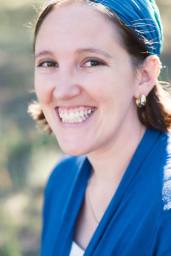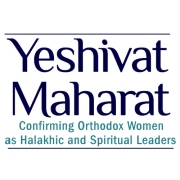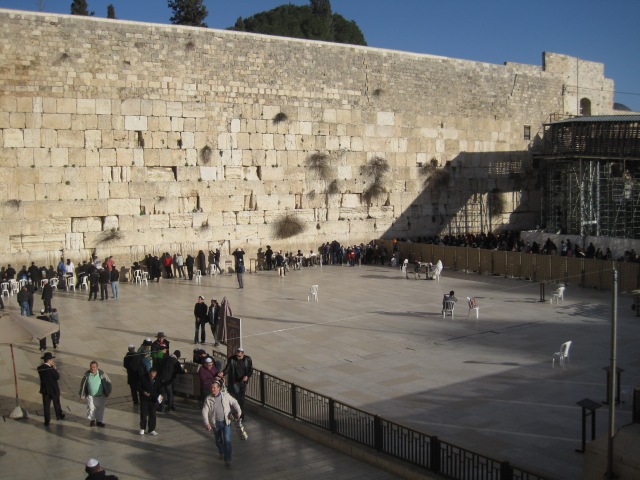I had the distinct honor to be at the kotel for Rosh Chodesh Sivan. At least, that is what I believed as I left my house that morning and wrote this on Facebook:
I believe that prayer is a communal mitzvah. I believe that Rosh Chodesh is a special time for women. I believe that women’s Rosh Chodesh tefilla is particularly powerful.
Honored to be able to back up my beliefs and join Women of the Wall on Rosh Chodesh Sivan….
Two days after Yom Yerushalyim and five days before Shavuot – ’tis the season to remember that this is everyone’s Jerusalem and everyone’s Torah.
But then I got there, and honor wasn’t one of the first words that came to mind.
I initially wrote a long and detailed post of the entirety of my experience that morning, but it is just that – one experience in thousands with all the emotions attached. I do not honestly believe that rehashing each of those moments adds something to the narrative of the day, nor will it help anyone move forward or reconcile the difficulties that it may have provoked. What I think I can add is a very unique viewpoint based on just a few moments and the take home message I’m trying to carry forward.
—

Photo by Noam Revkin Fenton – Post by Melissa
When I showed up at the kotel at 7:02am on Friday morning I could have been part of nearly any of the four groups that were there that day: those who praying at the kotel because that’s just their normative experience, those who were praying with Women of the Wall (WoW, a group of women who have held Rosh Chodesh services at the kotel for ~25 years with many of them wearing ritual garments), those who were praying with Women for the Wall (a new group started by women who do not feel the need for public prayers from women and/or the wearing of ritual garments at the kotel), and those who were actively protesting Women of the Wall.
As a visibly Dati Leumi (essentially Israeli/Zionist Modern Orthodox) woman, I moved relatively easily through the masses of religious men to get to the women’s side, and again through the masses of religious women to try and find where I was hoping to be. I said “slicha” (excuse me) and snaked my way through, but no one really paid any attention to me. I couldn’t find Women of the Wall amidst the thousands of people at the kotel, so I found one friend and we decided to pray Psukei d’Zimra together in the women’s section and hoped someone would text her with details on where we could find the group. That is when everything changed for me. You see, the friend I was with prays every morning wearing her tallit and tefillin – this is as much a part of her day and her religious experience as putting my head-covering on is for me. She donned her ritual garments and we prayed shoulder to shoulder, shuckling together through the psalms, and trying to focus on the words of our tefilla and not the stares and whispers around us. At one point, she identified the location of WoW so we decided to make our way over.
I took my friends hand to lead us out and keep us together. Immediately the girls who had moved out of my way before blocked my path. Contrary to everything else I have seen reported about the women and girls, they were not all just davening peacefully. They may have been quieter and more subtle than the men, but they were hissing and spitting at us. They pointed, smirked, and took our photo. They yelled out that we were not Jewish and what we were doing was not Judaism, and many other things which I didn’t hear clearly and/or understand. We tried to stay focused and in the moment, quietly moving forward and towards our goal and out of their line of fire. [A few women did remark to my friend about her courage, bravery, and dedication (which she surely appreciated) and a few women approached us to ask where WoW was as they had also been unable to find the group.]
It was amazing to me that in a split second, the time it took to grasp my friend’s tefillin clad hand, I went from being perfectly acceptable, to a complete outsider. That in one moment, I went from being able to move about freely, to needing security personnel to protect me from those who wanted to hurt me. That in an instant I personally became the target of spit, water, eggs, curses, rocks, and even “the finger” as we drove away in the busses brought in to escort us out. Nothing about me changed from when I walked into the kotel plaza unnoticed to when I exited the Egged bus two hours later, and yet to a segment of the population my very being changed and made me an equal recipient of those actions. My heart still aches when I think about those sights and sounds, and I am still conflicted when I try to rectify the dichotomy in my head.
It is impossible to say how many people were at the kotel on Friday morning or how many were there for any of the four reasons I previously identified, but what I feel confident in saying is that on some level, the people who were there with any of these four groups want the same thing. We all want to be able to pray the same words of the same tradition in the same place. We are all looking to connect to God – we just have different ways of doing that. We have to find a way to use our common spiritual ground to create a common physical ground, even when we will never have a common practical religious ground. Deep down, we are all the same.
Rosh Chodesh Sivan falls just two days after Yom Yerushalyim, the day which commemorates and celebrates the Six Day War in 1967 in which Israel reclaimed Jerusalem (and so much more!) and provided access to the kotel and Old City after 19 years of it being locked up under Jordanian rule. I was there on Wednesday, singing and dancing to a band as thousands of people (mostly Dati Leumi) celebrated the ability to come to the kotel to pray. Rosh Chodesh Sivan is just five days before Shavuot, the day where we commemorate and celebrate receiving the Torah at Mount Sinai – man, woman, and child. Thousands will again descend on the kotel that morning after staying up all night learning to celebrate the greatest gift of all – Torah. Three times in one week, thousands of people will have gathered at this holy site to pray and celebrate – each in their own way. (Yes, there were also those who will have been there neither celebrating nor praying, but they are the minority in the grand scheme and we cannot let them overtake the deeper and more meaningful connections which are at our fingertips.)
In retrospect and having stepped back from the intense emotions of the day, I have to say that I am again honored to have been there. There were thousands of people from across the Jewish spectrum gathered together in this holy space: women and men, young and old, those who made a conscious decision and those who were bussed there by their seminaries, those who believe in women’s tefillah groups and those who oppose them, those who prayed and those who protested, those who want a change at the kotel and those who support the status quo. But at the end of the day, they were all there because their Judaism is so important to them that they want to be sure they have a way to honor it publicly at only of the holiest places we can access.
I hope and pray that we can unite around that and not continue to let the nuances around it divide us.








